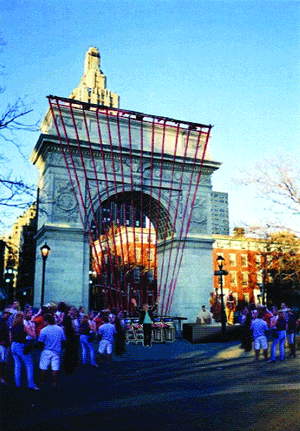By Albert Amateau
Imagine the Washington Square Arch transformed into a 60-foot-tall harp whose strings vibrate with the wind, pick up ambient sound and radio and television waves, all combining in a strange but harmonic music controlled at a console at the base of the arch.
The proposal for “City Harp,” invented and played by Christopher Janney, who makes public music with public architecture, would be seen and heard for 10 days in October 2006, if it wins community and city approval.
Janney, who lives in the Boston area, and Aviva Davidson, executive director of Dancing in the Streets, the public-arts organization sponsoring the installation, came to the Dec. 6 Community Board 2 Parks Committee meeting to make a preliminary pitch.
“It’s based on the Aeolian harp, an ancient instrument played by the wind. And we hope to have its world premiere the first 10 days in October,” said Davidson. “We’ve been talking to the Department of Parks and Recreation and we’ve been told that it would not damage the arch. We hope to get their approval and come back to you for your blessings,” she told the committee.
Intrigued but wary, committee members pressed for details. Honi Klein, a public member of the committee, urged that residents of the Fifth Ave. buildings north of the arch be notified. Rosemary McGrath, a longtime board member, said she feared for the structural integrity of the 110-year-old marble monument.
Davidson replied that notices would go out this week to neighbors of the arch. Janney, trained in architecture at Princeton and in environmental arts at Massachusetts Institute of Technology, said the installation would have as little contact as possible with the 110-year-old monument.
The harp’s 16 red elastic strings, some an inch in diameter, would be anchored in a vessel of water resting on the roof and would hang down the park side of the arch without touching the parapet, Davidson told the committee. The strings would taper to the console on the ground in the center under the arch.
A Department of Parks spokesperson confirmed that Janney and Davidson have presented the project to the department’s technical staff but no decision has been made yet.
The strings would vibrate with the wind all the time but the volume of the sound would be controlled at the console and could be made inaudible, Janney said.
The basic plan, subject to community board and neighborhood approval calls for the sound of the harp to be audible — primarily inside the park — from 10 a.m. to 6 p.m. with Janney or an associate at the console mixing sound and controlling volume.
As part of the installation, “Playing With the City,” a series of 10 musical pieces, composed by Janney and based on jazz progressions and Indian ragas — melodies traditionally played at different times of day — would be performed by musicians on tabla, saxophone and string bass.
During the 10-day installation, the musicians, accompanied by Janney at the “City Harp” console, would play one of the appropriate 10 pieces, beginning the first day in the morning and progressing each day to a later time, going from morning on to noon, afternoon and evening.
“It could be the whole program or any part of it, or nothing,” said Davidson. “It’ll depend on what the community wants.”
Janney, who created a multimedia studio, PhenomenArts, Inc., in 1980, has toured the U.S. and Europe with interactive sound/ architecture installations from The Spanish Steps in Rome to the subways in Boston and Paris. He is a visiting professor at The Cooper Union. In 1983, he created “Heartbeat” for Sara Rudner of Twyla Tharp Dance, with an instrument that amplified Rudner’s heartbeat as she moved. Mikail Barishnikov premiered “Heartbeat:mb” at City Center in 1999 and has since performed it around the world.





































